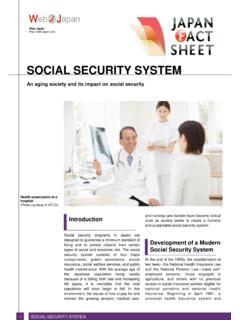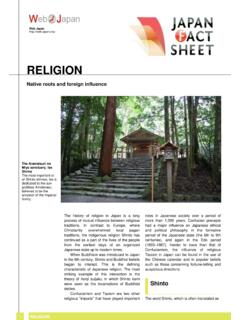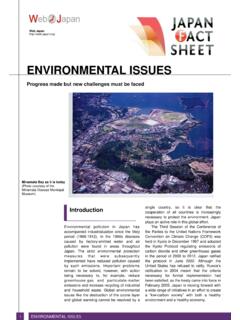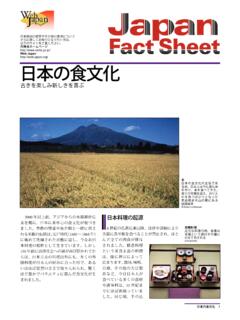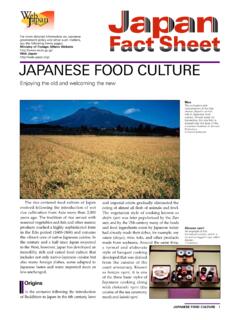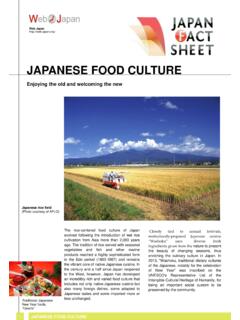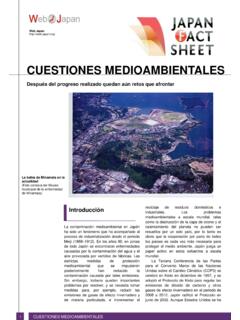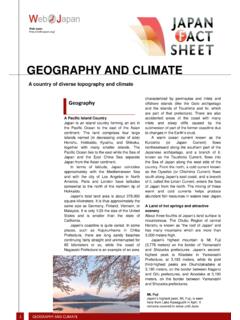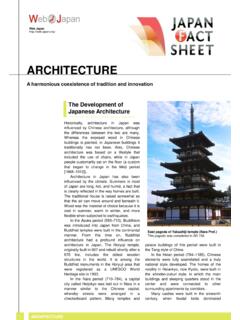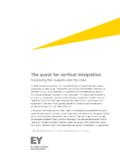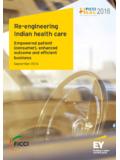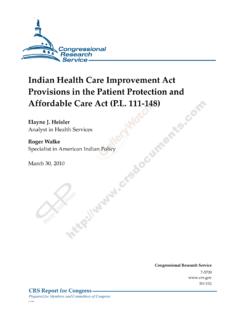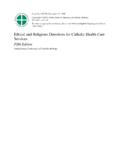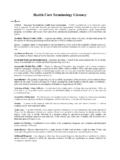Transcription of HEALTH CARE - Web Japan
1 Web Japan HEALTH care . Aiming for high-quality and sustainable HEALTH and medical services An ambulance (Photo courtesy of AFLO). Today the medical system in Japan is at the Introduction world's highest level in many respects, such as average life expectancies and the death rates of infants and small children. At the Systematized medical care in Japan dates same time, the system is faced with a number from the introduction of Chinese medicine in of challenges, including the small number of the 6th century.
2 This medical tradition medical professionals (doctors, nurses, etc.). produced many noted Japanese physicians per bed and the long length of the average and continued up to the Meiji Restoration hospital stay. In the 21st century, the medical (1868). At that time Western medicine was system will have to cope with changes in the promoted as a national policy, and this led to disease structure, changes that include the the development of Japan 's modern medical growing prevalence of psychiatric disorders system.
3 Rapid economic growth in the such as depression, the appearance of new postwar period brought a marked infectious diseases like SARS, and, most of improvement in Japan 's standard of living, all, the greater number of cases of geriatric and, at the same time, remarkable progress disease that will result from the rising average was made in all aspects of public HEALTH . age of the population. 1 HEALTH care . Senior care Home helpers have an increasingly important role to play in enabling the elderly to live independently, helping to reduce the cost to society of institutional care .
4 (Photo courtesy of AFLO). Medical Services Various factors, such as improvements in the one of six HEALTH insurance plans. Chief environment, advances in medical technology, among them are employees' HEALTH insurance, and the upgrading of medical facilities during which covers most private-sector employees, the past 40 to 50 years, account for a drastic and National HEALTH Insurance, which covers change in the nature of the population's the self-employed, the unemployed, retired illnesses. Tuberculosis, the leading cause of persons, and other ineligible for employee death in 1950 at deaths per 100,000 HEALTH insurance.
5 Other plans provide people, has now fallen to less than 2 deaths coverage for seamen, national public-service per 100,000 people. employees, local public-service employees, Cerebrovascular diseases (stroke), the and private-school teachers and employees. leading cause of death in the 1960 1970 Under Japan 's medical insurance plans, 20%. period, decreased in the latter half of the of medical expenses are paid by recipients for 1970s. Since the 1980s, the leading cause of newborns and pre-elementary school death has been cancer, which has been children; 30% for elementary school children claiming an increasing number of victims through to 69-year-olds; for those aged 70-74.
6 Every year. Surveys conducted by the the ratio is 20% in principle (10% for anyone Ministry of HEALTH , Labour, and Welfare in who turned 70 by March 2014; and 30% for 2016 reveal that cancer was the cause of anyone who has an income equivalent to that of all mortalities, followed by heart of an active employee). And anyone aged 75. disease at , and pneumonia at and over pays 10% in principle (or 30% if National medical expenditures came to they have an income equivalent to that of an trillion yen in fiscal 2015, or 333,300 yen per active employee).
7 Those 75 or older are capita, and were equivalent to of enrolled in a separate system from the national income. general HEALTH - care system, the Long Life The foundation of medical services in HEALTH care System. The insurance carrier Japan is the public universal HEALTH - care then remunerates the doctor, hospital, clinic, insurance system in which every citizen in or other medical care provider directly for the Japan is enrolled as a rule and a free access remainder on a fee-for-service basis as system that allows patients to choose their determined by the Ministry of HEALTH , Labour preferred medical facility.
8 The HEALTH - care and Welfare. provision system has built in these two key This universal medical care insurance aspects so that everyone, regardless of system gives all citizens access to adequate where they live, can be sure to obtain medical medical care , thus contributing greatly to their services. Efforts are also being made to peace of mind and to the overall level of introduce, on an experimental basis, new HEALTH in society. medical services for those living in remote locations, such as mountainous areas, so that they can receive medical services via the HEALTH and Medical Internet and other communication technologies.
9 Services for the Elderly The percentage of Japan 's population aged 65 or over was in 1970. Just 43 years The Japanese HEALTH later, in 2013, it was more than As of Insurance System September 2016, Japan had million elderly people. Today one in every three A HEALTH Insurance Law amendment which people is 65 years or older, and in 2060 the went into effect in 1961 entitles all Japanese ratio will likely be one in people. In citizens and resident aliens to coverage under fiscal 2014, medical expenditures for this 2 HEALTH care .
10 The main hospital building at the National Cancer Center group stood at trillion yen or of the total for men and trillion yen or of the total for women. Thus, per-capita spending amounted to 774,300 yen for men (181,400 yen for those 65 and under). and 686,700 yen for women (177,900. yen for those 65 and under). Through advances in medical treatment technology, the best medical care available can be given, yet at the same time this can lengthen the period of care . In addition, with the progressing trend toward nuclear families and women entering the work force, caring for the elderly at home has become difficult for received.
